If you own a John Deere 3025e tractor, you might encounter some common issues that could impact its performance. From engine overheating concerns to electrical wiring problems, these challenges can disrupt your work and lead to costly repairs. By being aware of these 10 common problems, you can take proactive steps to address them before they escalate. Stay tuned to discover practical tips on how to tackle these issues and keep your John Deere 3025e running smoothly.
Things to Note
- Overheating issues due to faulty thermostat or clogged radiator can affect engine performance.
- Hydraulic power problems may arise from damaged hoses, low fluid levels, or contaminated fluid.
- PTO engagement difficulties can result from debris, clutch issues, or misaligned shafts.
- Transmission troubles like shifting issues, fluid leaks, or clutch problems can occur.
- Electrical system issues such as damaged wires, connectors, or battery drainage can impact tractor operation.
Engine Overheating
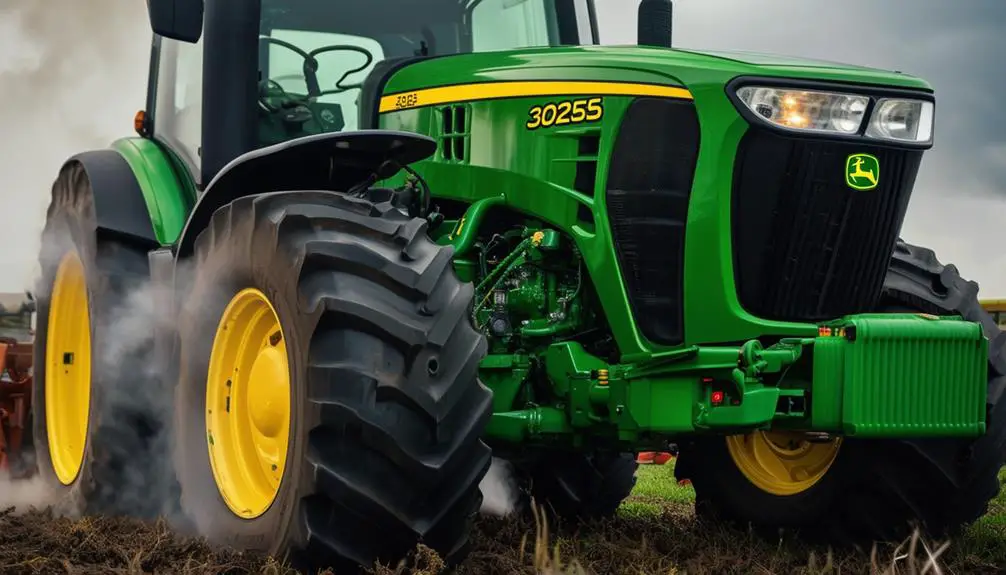
If your John Deere 3025e is experiencing engine overheating, it may be due to a faulty cooling system. To resolve this issue, start by checking the coolant level in the radiator. Verify it's at the appropriate level and not diluted with water.
Next, inspect the radiator for any blockages or debris that could be impeding airflow. Clean the radiator thoroughly to allow for proper cooling.
Another common culprit for engine overheating is a malfunctioning thermostat. If the thermostat is stuck closed, it will prevent coolant from circulating properly, leading to overheating. In this case, replacing the thermostat should solve the problem.
Regular maintenance is key to preventing engine overheating. Make sure to change the coolant as recommended by the manufacturer and keep an eye on the overall condition of the cooling system.
Transmission Issues
If you're experiencing shifting issues with your John Deere 3025e, it's important to get them diagnosed promptly.
Identifying fluid leaks early on can prevent further damage to your transmission system.
Challenges with clutch engagement should also be addressed to secure smooth operation of your tractor.
Shifting Problems Diagnosed
Diagnosing shifting problems in your John Deere 3025e involves checking for any transmission issues that may be causing the difficulty. If you're experiencing trouble shifting gears, one common culprit could be low or contaminated transmission fluid. Confirm the fluid level is correct and that it appears clean and free of debris. If the fluid seems dirty or has a burnt smell, it may be time for a fluid change.
Another potential reason for shifting problems could be a clutch that needs adjustment or replacement. If you notice slipping gears or difficulty engaging or disengaging the transmission, the clutch might be the issue. It's crucial to inspect the clutch components to determine if they're worn out or require readjustment.
Additionally, problems with the shift linkage or shifter forks could also lead to shifting issues. Check for any signs of damage or misalignment in these areas.
Fluid Leaks Identified
Identify fluid leaks promptly to address potential transmission issues in your John Deere 3025e. Keeping a close eye on any leaks can save you time and money in the long run. Below is a table to help you identify common fluid leaks and their possible causes in your John Deere 3025e:
| Fluid Color | Possible Cause |
|---|---|
| Red | Transmission fluid leak |
| Black | Engine oil leak |
| Green/Yellow | Coolant leak |
| Clear | Hydraulic fluid leak |
| Blue | Diesel fuel leak |
Regularly inspecting your tractor for leaks and addressing them promptly can prevent more significant transmission issues down the line. If you notice any fluid leaks, it's crucial to determine the source and take the necessary steps to fix them promptly. By staying proactive, you can guarantee your John Deere 3025e operates smoothly and efficiently.
Clutch Engagement Challenges
Addressing clutch engagement challenges in your John Deere 3025e can help ensure smooth operation and prevent potential transmission issues. When you encounter difficulties with clutch engagement, such as grinding gears or slipping, it can lead to wear and tear on your transmission components.
To enhance performance, start by checking the clutch pedal adjustment. If the pedal isn't set correctly, it can cause improper engagement. Additionally, inspect the clutch linkage for any signs of damage or wear that may be affecting its operation. Keep an eye out for any leaks that could be contaminating the clutch plate, leading to slippage.
Regular maintenance, including proper lubrication of moving parts, can also contribute to smoother clutch engagement. By addressing these challenges promptly, you can maintain the integrity of your transmission system and keep your John Deere 3025e running efficiently.
Hydraulic System Leaks
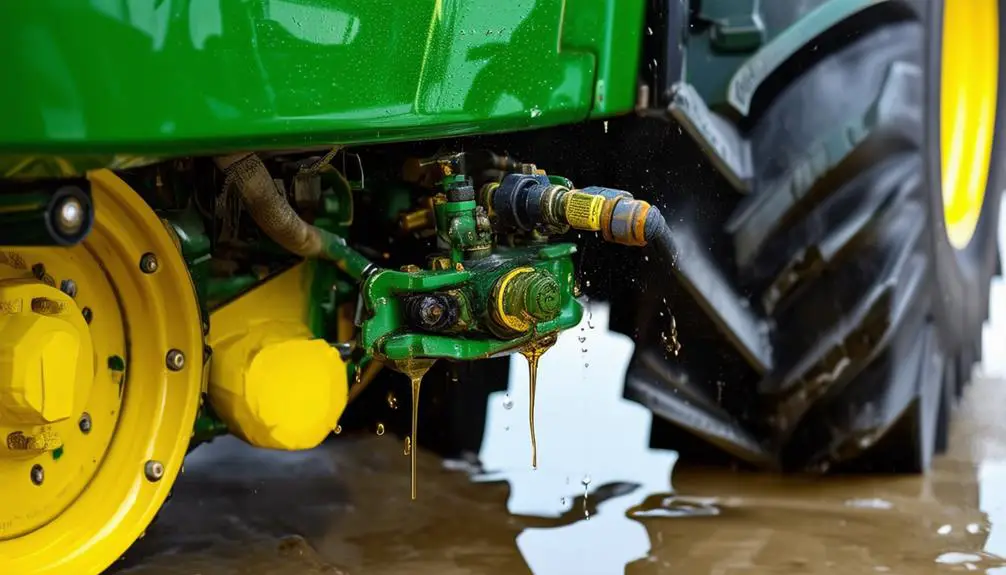
If you notice hydraulic fluid pooling under your John Deere 3025e tractor, it may indicate a potential hydraulic system leak. These leaks can lead to decreased performance and even damage if left unattended. Here's a quick overview to help you identify and address hydraulic system leaks on your tractor:
| Symptom | Possible Cause | Solution |
|---|---|---|
| Visible Fluid Leaks | Damaged hoses or fittings | Inspect and replace damaged components |
| Weak Hydraulic Power | Low fluid levels or air in the system | Check fluid levels and bleed the system if necessary |
| Unusual Noises | Pump cavitation or internal damage | Have a professional check and repair the system |
| Slow Implement Response | Clogged filters or contaminated fluid | Replace filters and flush the system |
| Jerky Movements | Valve blockage or pressure issues | Clean or replace valves to guarantee proper function |
Electrical Wiring Problems
You may encounter issues with faulty wire connections and battery drainage on your John Deere 3025e.
These electrical wiring problems can lead to operational disruptions and impact the overall performance of your tractor.
It's important to address these issues promptly to guarantee smooth functioning and prevent further complications.
Faulty Wire Connections
Properly maintaining the electrical wiring connections on your John Deere 3025e is vital to prevent performance issues. Faulty wire connections can lead to various electrical problems that may hinder the functionality of your tractor. When wires become loose or corroded, it can disrupt the flow of electricity and cause components to malfunction.
To avoid these issues, regularly inspect all wire connections for any signs of wear or damage. Make sure that the wires are securely fastened and free of any debris that could interfere with the connection.
If you encounter faulty wire connections, it's important to address them promptly. Replace any damaged wires and connectors to restore proper functionality to your John Deere 3025e. Ignoring these issues can lead to more significant problems down the line and may result in costly repairs.
Battery Drainage Issues
Regular examination of wire connections is crucial in preventing battery drainage issues on your John Deere 3025e due to potential electrical wiring problems. Faulty wire connections can lead to excessive power draw even when your tractor is turned off, causing your battery to drain unexpectedly.
To avoid this inconvenience, make sure to check the condition of your wires regularly. Look for any signs of fraying, corrosion, or loose connections that could be contributing to the battery drainage problem.
If you notice any issues with the wiring, address them promptly to prevent further battery drainage and potential damage to your John Deere 3025e's electrical system. By taking a proactive approach to maintaining your wire connections, you can guarantee that your tractor's battery remains charged and ready to use whenever you need it.
Steering Difficulties
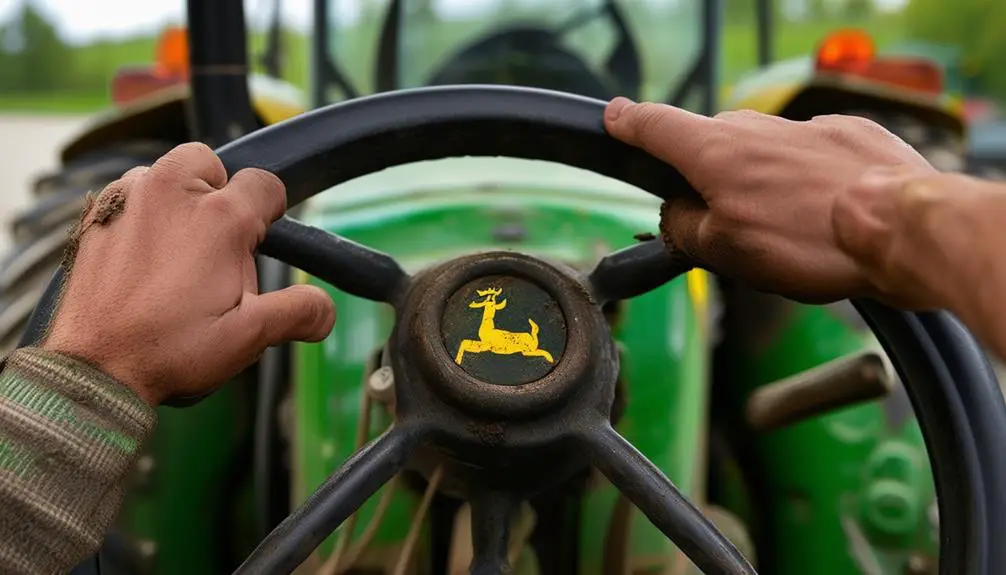
Experiencing challenges with the steering system is a common issue reported by John Deere 3025e owners. When you're out there tending to your land, the last thing you want is a steering system that gives you trouble. Whether it's feeling stiff or not responding as smoothly as it should, steering difficulties can be annoying. One of the main culprits behind these issues is often improper lubrication or worn-out components within the steering mechanism. It's crucial to address these problems promptly to avoid further damage and guarantee your safety while operating the tractor.
If you notice any unusual resistance or lack of responsiveness in your steering wheel, it's vital to investigate the root cause. Checking the steering fluid levels and the condition of the steering components can help pinpoint the issue.
Regular maintenance and proper care of the steering system can go a long way in preventing these difficulties from arising. Remember, a well-functioning steering system is key to efficiently maneuvering your John Deere 3025e, so don't overlook any signs of trouble.
PTO Malfunctions
If you're experiencing PTO malfunctions on your John Deere 3025e, you may be dealing with PTO engagement issues or PTO shaft alignment problems.
These issues can cause disruptions in your equipment's performance and functionality.
It's important to address these issues promptly to guarantee smooth operation.
PTO Engagement Issues
Having trouble with PTO engagement on your John Deere 3025e? PTO engagement issues can be frustrating when trying to get work done efficiently. Here are some common problems and potential solutions to help you get back to work:
| Issue | Possible Solution |
|---|---|
| PTO not engaging | Check for any debris or obstructions around the PTO. |
| PTO engagement slipping | Inspect the PTO clutch for wear and tear. |
| PTO shaft not turning | Verify that the PTO shaft is correctly aligned. |
| PTO engagement too noisy | Lubricate the PTO components to reduce friction. |
PTO Shaft Alignment
Check the PTO shaft alignment if you encounter malfunctions related to the PTO on your John Deere 3025e. Misaligned PTO shafts can lead to issues such as vibrations, noise, or even failure to engage properly. To guarantee smooth operation, start by inspecting the alignment of the PTO shaft with its corresponding components.
Look for any signs of misalignment, such as unusual gaps or angles. If you notice any discrepancies, realign the shaft to secure proper positioning. Remember, a well-aligned PTO shaft not only prevents malfunctions but also promotes efficiency and longevity of your equipment.
Regularly checking and maintaining the alignment of your PTO shaft can save you time and money in the long run. By taking control of this aspect of your John Deere 3025e, you empower yourself to keep your equipment running smoothly and effectively.
Fuel System Troubles
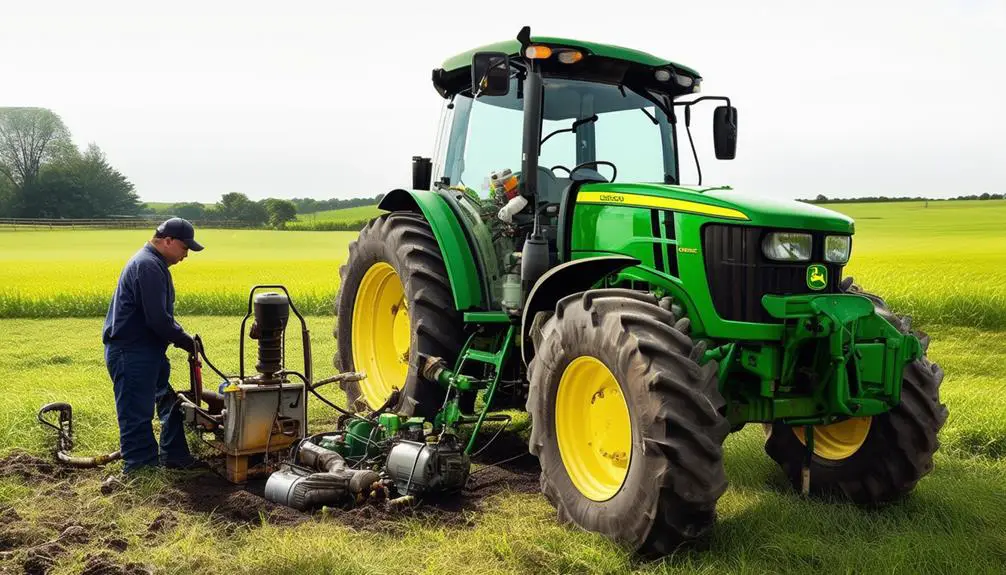
When experiencing fuel system troubles with your John Deere 3025e, start by checking for any visible leaks or blockages in the fuel lines. These issues can often be the root cause of poor engine performance or stalling. If you notice any leaks, address them promptly to prevent further complications.
Another common problem in the fuel system is a clogged fuel filter. Over time, dirt and debris can accumulate in the filter, restricting the flow of fuel to the engine. Regularly inspect and replace the fuel filter to ensure peak performance.
In some cases, the fuel injectors may become dirty or malfunction, leading to uneven fuel distribution and engine misfires. Consider cleaning or replacing the fuel injectors if you experience rough idling or a decrease in power.
Lastly, inadequate fuel quality can also impact the performance of your John Deere 3025e. Make sure you're using high-quality fuel to prevent issues with the fuel system and maintain the longevity of your tractor.
Tire Wear and Tear
Inspect your John Deere 3025e's tires regularly for signs of wear and tear to guarantee peak efficiency and safety. Your tires are the foundation of your machine, impacting traction, stability, and overall effectiveness.
Freedom starts with taking control of your maintenance routine, ensuring that your tires are in prime condition for whatever tasks lie ahead.
Check for uneven wear patterns, which can indicate alignment issues or improper tire inflation. Addressing these concerns promptly can prevent further damage and extend the life of your tires.
Look out for cuts, punctures, or bulges that may compromise the integrity of the tire. These issues not only affect performance but also pose safety risks during operation.
Rotate your tires regularly to promote even wear across all four wheels, maximizing their lifespan.
Proper tire maintenance is key to optimizing the full potential of your John Deere 3025e and maintaining a safe working environment. Prioritize tire care, and your machine will thank you with reliable performance and longevity.
Starter Motor Failure
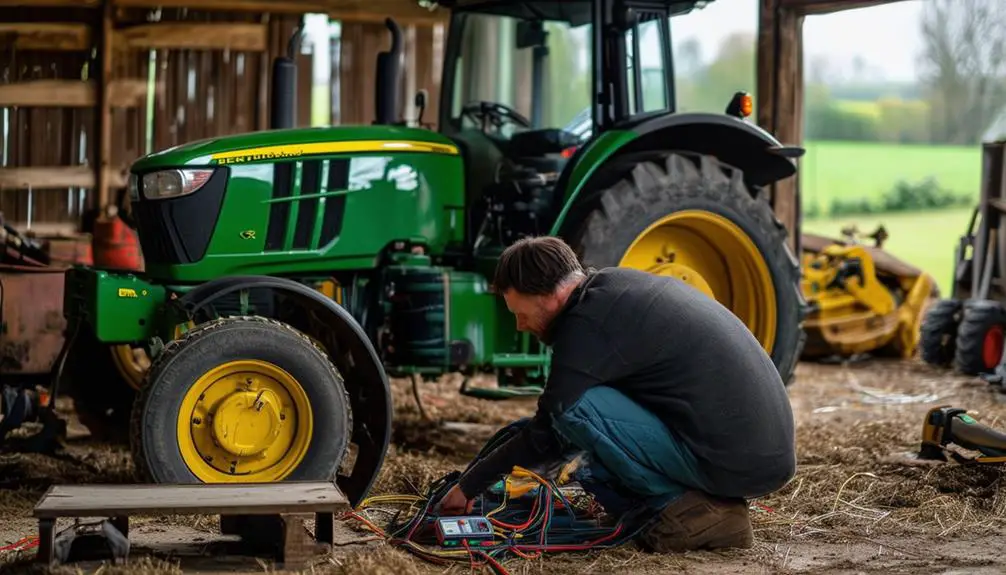
Are you experiencing problems with your John Deere 3025e's starter motor failing unexpectedly?
Dealing with a starter motor failure can be frustrating, especially when you're ready to get to work or hit the fields.
When your John Deere 3025e encounters starter motor problems, it can halt your plans and disrupt your day.
The starter motor is a vital component that initiates the engine's operation, allowing you to get your tasks done efficiently.
Common causes of starter motor failure in John Deere 3025e tractors can include issues with the electrical connections, a worn-out starter motor, or even problems with the ignition switch.
It's crucial to address these problems promptly to avoid further complications and guarantee your tractor runs smoothly.
If you're facing starter motor issues, don't hesitate to seek professional help to diagnose and fix the problem promptly.
Cooling System Malfunctions
Experiencing overheating issues with your John Deere 3025e? Cooling system malfunctions can disrupt your tractor's performance and lead to costly repairs if left unaddressed. One common problem is a faulty thermostat, which can cause the engine to overheat. Additionally, a leak in the radiator or hoses can result in a loss of coolant, leading to overheating issues. To help you better understand potential cooling system malfunctions, below is a table outlining common issues and their possible solutions:
| Cooling System Malfunctions | Possible Solutions |
|---|---|
| Faulty Thermostat | Replace thermostat |
| Radiator/Hose Leaks | Repair leaks |
| Clogged Radiator | Flush radiator |
| Water Pump Failure | Replace water pump |
Regularly inspecting your John Deere 3025e's cooling system can help prevent these malfunctions. By addressing issues promptly, you can make sure your tractor runs smoothly and avoid costly repairs down the road.
Frequently Asked Questions
Can the John Deere 3025E Handle Heavy-Duty Attachments?
Yes, the John Deere 3025e can handle heavy-duty attachments. It's designed to tackle tough tasks with ease, making it a reliable choice for heavy-duty work.
Whether you need to use a loader, backhoe, or any other attachments, the 3025e is up to the challenge. Its robust build and powerful engine guarantee that you can confidently take on demanding projects without worrying about its capabilities.
How Often Should I Service the Air Filter on a 3025e?
When it comes to your trusty John Deere 3025e, ensuring the air filter gets some TLC is key. Regularly servicing it's like giving your tractor a breath of new air – about every 100 hours of use or once a year is a good rule of thumb.
What Are Common Maintenance Tips for the 3025e's Battery?
To keep your John Deere 3025e's battery in peak condition, make sure to regularly check the battery terminals for corrosion and clean them as needed.
Additionally, it's essential to inspect the battery's water level if it's not maintenance-free.
Remember to tighten the battery connections and keep the battery securely in place to prevent damage.
Following these simple maintenance tips can help extend the life of your 3025e's battery.
Are There Recommended Tire Pressure Settings for the 3025e?
Wondering about the recommended tire pressure settings for your 3025e?
It's crucial to maintain the correct tire pressure for best performance. Improper pressure can affect traction, fuel efficiency, and overall handling.
Check your owner's manual for the manufacturer's recommended tire pressure specifications.
Regularly monitoring and adjusting tire pressure according to guidelines will help keep your 3025e running smoothly and efficiently.
How Can I Prevent Rust on the John Deere 3025e?
To prevent rust on your John Deere 3025e, make sure to clean and dry the tractor regularly. Keep an eye out for any scratches or nicks in the paint and touch them up promptly.
Applying a rust inhibitor or protective coating can also help shield your tractor from rust. Additionally, storing your tractor in a dry, covered area when not in use can further prevent rust from forming.
Conclusion
Now that you know the common problems with your John Deere 3025e tractor, remember to stay on top of maintenance to avoid costly repairs.
Imagine being in the middle of a busy harvest season when your tractor's engine overheats due to a simple radiator blockage that could have been prevented with regular checks.
Don't let a small issue turn into a major headache – take care of your tractor and it will take care of you.